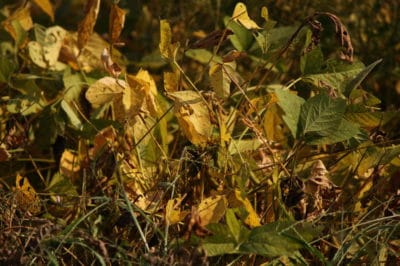About Soybeans
Soybeans are bushy legume plants that produce high protein seeds. In the US, they are primarily grown for animal feed, but in the Orient, soybeans are an important human food source. They are used for fermented foods such as tofu, tempeh and soy sauce. The beans are easy to grow in the home garden and are commonly used green as edamame.
Soybean Rust Basics
Soybean rust is caused by two fungi: Phakopsora pachyrhizi (Asian soybean rust) and Phakopsora meibomiae (New World soybean rust). The former is the bigger problem. Yield losses in infected fields can be as high as 80 percent. The fungus causes lesions on the leaves and will eventually kill the plant. It is spread by windblown spores.
Soybean Rust Hosts
In addition to the soybean, many other plants act as hosts for soybean rust, which is one reason it is so hard to control. These include:
- Dry beans like pintos and kidney beans.
- Various kinds of peas.
- Leguminous forage crops like clover and trefoil.
- Kudzu, an invasive vine in the South.
Soybean Rust Symptoms
In the early stage of the infection – usually just after flowering – soybean rust causes the upper side of the leaves to turn yellow in an irregular pattern called mosaic. Eventually the disease spreads, causing the undersides of the leaves to yellow. The fungus attacks stems and pods as well and can cause defoliation. Asian Soybean Rust also produces pustules on the underside of the leaf.
Preventing Rust
Growing strong, healthy plants may increase resistance. Temperature and humidity are major factors in the appearance of the disease. While you cannot control either of these, your watering practices can make the problem worse. Use drip irrigation or a soaker hose rather than a sprinkler. Avoid wetting the leaves and never work with plants when they are wet. Immediately remove and burn affected plants.
Treating Infected Soybeans
Organic gardeners have limited options in treating soybean rust, as most fungicides are not organic and can cause damage to soil microorganisms. Commercial growers often use a biofungicide called Ballad. Neem oil sprays may be of use when applied to both the soil and plant leaves. Tea tree oil, clove, thyme and citronella oils have been found to be effective against other rusts but have not been tested on soybeans.
